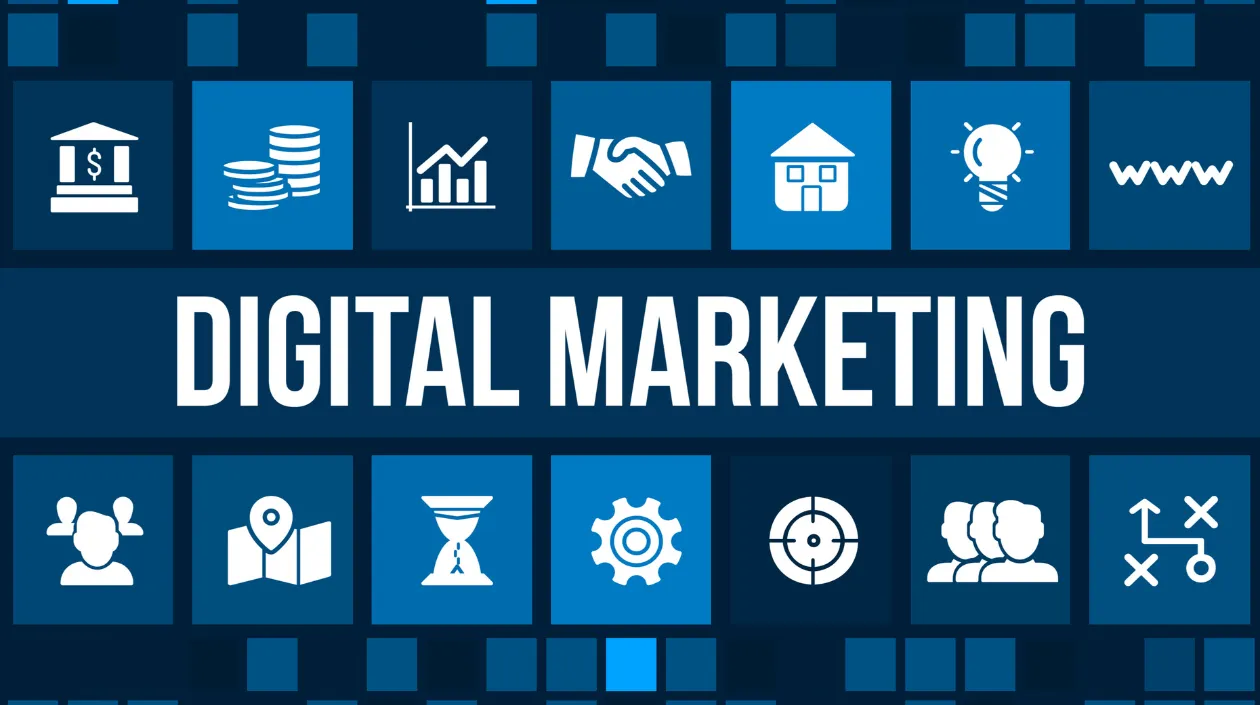Introduction: The Ever-Evolving World of Digital Marketing
Digital marketing is constantly evolving, driven by advancements in technology, shifting consumer behavior, and new platforms emerging on the scene. What works today may not work tomorrow, and businesses that fail to stay ahead of digital marketing trends risk falling behind. Whether it’s artificial intelligence (AI), voice search, or video marketing, staying on top of the latest trends is crucial for businesses looking to engage with their audience and drive growth.
In this blog, we’ll explore the top digital marketing trends that are expected to shape the future of marketing. By understanding and embracing these trends, businesses can stay competitive, build stronger customer relationships, and adapt to the digital landscape.
1. Artificial Intelligence and Machine Learning
Artificial Intelligence (AI) and Machine Learning (ML) are already revolutionizing digital marketing, and their impact is expected to grow exponentially in the coming years. AI can help businesses automate processes, analyze data, personalize content, and even make real-time decisions that improve customer experiences.
How AI and ML Are Shaping the Future of Digital Marketing:
Personalization at Scale: AI and ML allow businesses to deliver highly personalized content and experiences. By analyzing data such as browsing history, preferences, and previous interactions, AI can recommend products or content that’s highly relevant to each individual user.
Chatbots and Virtual Assistants: AI-powered chatbots are becoming increasingly sophisticated and can handle more complex customer service tasks. They help businesses provide 24/7 support, engage users, and answer questions in real-time, improving customer satisfaction and reducing operational costs.
Predictive Analytics: AI tools can predict customer behavior, trends, and purchasing patterns, enabling businesses to optimize their marketing strategies and target the right audience with the right messages at the right time.
As AI and ML technologies evolve, digital marketers will be able to provide more efficient and effective marketing strategies, resulting in better customer experiences and improved business outcomes.
2. Voice Search Optimization
With the growing popularity of voice assistants like Amazon Alexa, Google Assistant, and Apple Siri, voice search is becoming an essential part of the digital marketing landscape. Consumers are increasingly using voice search for queries ranging from simple facts to shopping.
How Voice Search Is Changing Digital Marketing:
Natural Language Processing (NLP): Voice searches are often longer and more conversational than traditional text-based searches. Marketers will need to focus on long-tail keywords and natural language to optimize for voice search queries.
Local SEO: Voice searches are often location-based, with users looking for nearby businesses, restaurants, or services. Local SEO will become more critical as businesses aim to capture voice search traffic from nearby customers.
Optimizing for Featured Snippets: Voice assistants often read out featured snippets (position zero results) in response to voice queries. Marketers should optimize their content to appear in these prime positions for voice search results.
Voice search is expected to continue growing, and businesses that optimize their digital content for voice search will have a significant advantage in reaching potential customers.
3. Video Marketing’s Continued Dominance
Video marketing has exploded in popularity in recent years, and it shows no signs of slowing down. Video is a powerful tool for storytelling, brand awareness, and consumer engagement. Whether on social media, websites, or video-sharing platforms like YouTube, video remains one of the most engaging and effective formats for reaching audiences.
How Video Marketing Is Shaping the Future of Digital Marketing:
Short-Form Video Content: With platforms like TikTok and Instagram Reels gaining traction, short-form video content is becoming an increasingly important way for brands to engage with audiences. These bite-sized videos are easy to consume and share, making them ideal for building brand awareness and creating viral content.
Live Streaming: Live video is another trend gaining momentum. Brands are using live streaming to host Q&A sessions, product launches, events, and behind-the-scenes content, offering audiences a more authentic and real-time connection with the brand.
Interactive Video: Interactive videos that allow users to choose their path or engage with the content (such as clickable links or choices in the video) are becoming more popular. These videos offer a unique, engaging experience that encourages users to stay longer and participate in the content.
As video content continues to dominate, businesses should incorporate video into their digital marketing strategy to capture the attention of their audience and increase engagement.
4. Augmented Reality (AR) and Virtual Reality (VR)
The immersive capabilities of AR and VR are opening up new opportunities for brands to connect with consumers in innovative ways. These technologies are transforming how businesses market products and services, particularly in sectors like retail, real estate, and education.
How AR and VR Are Shaping Digital Marketing:
Virtual Try-Ons: Retailers are using AR to allow customers to virtually try on clothes, makeup, and accessories. This technology helps consumers make more informed purchasing decisions and enhances the shopping experience.
Immersive Brand Experiences: VR can be used to create immersive brand experiences that allow customers to interact with products or services in a fully virtual environment. For example, real estate companies can offer virtual property tours, or car manufacturers can let customers test-drive vehicles virtually.
Interactive Advertising: AR-enabled ads allow users to interact with products directly through their mobile devices. For example, an ad might allow a consumer to point their phone at an object and see how a piece of furniture would look in their living room.
As AR and VR technologies become more accessible, businesses will need to experiment with these tools to create engaging, immersive experiences that captivate their audience.
5. Influencer Marketing Evolution
Influencer marketing has become a mainstream part of digital marketing strategies, but its role is evolving. With the rise of micro-influencers (influencers with smaller but highly engaged followings), businesses are shifting away from traditional celebrity endorsements and focusing more on authentic, niche content.
How Influencer Marketing Is Evolving:
Micro and Nano Influencers: Brands are increasingly turning to micro and nano influencers who have smaller, more engaged audiences. These influencers often have more trust and authority within their niche communities, which can lead to higher conversion rates.
Long-Term Partnerships: Instead of one-off collaborations, brands are building long-term relationships with influencers to create authentic and consistent brand messaging over time. This approach helps build trust and credibility.
Influencer-Led Content: Influencers are now playing a more significant role in content creation, from product reviews to sponsored content. Businesses can leverage influencers to produce high-quality, user-generated content that resonates with their followers.
Influencer marketing will continue to evolve, with a greater emphasis on authenticity, niche communities, and long-term collaborations, offering businesses the opportunity to build deeper connections with their audiences.
6. Data Privacy and Ethical Marketing
As consumer concerns about data privacy grow, businesses will need to be more transparent about how they collect and use data. Ethical marketing, which respects consumer privacy and promotes transparency, is becoming increasingly important in building trust with audiences.
How Data Privacy and Ethical Marketing Are Shaping the Future:
GDPR and CCPA Compliance: Marketers will need to ensure that their campaigns comply with regulations like the General Data Protection Regulation (GDPR) and the California Consumer Privacy Act (CCPA), which protect consumer data and privacy rights.
Transparency and Trust: Consumers are more likely to engage with brands that are transparent about how they collect and use data. Offering clear privacy policies, providing opt-out options, and being transparent about data usage will help build trust.
Ethical Marketing Practices: Businesses are increasingly focusing on marketing in a way that aligns with their values, whether it’s through sustainability efforts, social responsibility, or inclusivity. Ethical marketing helps brands stand out in a crowded market and attract consumers who share their values.
As privacy concerns continue to rise, businesses must adopt ethical marketing practices that protect customer data and prioritize transparency.
7. The Growth of Subscription-Based Models
Subscription-based services have grown significantly in popularity, and this trend is expected to continue. From streaming platforms and e-commerce subscriptions to digital content services, businesses are moving towards recurring revenue models that offer customers ongoing value.
How Subscription Models Are Shaping the Future of Business:
Predictable Revenue Streams: Subscription models offer businesses a steady, predictable stream of income, which helps with budgeting and long-term planning. This stability allows companies to reinvest in their products and services.
Customer Retention: Subscription services often focus on building long-term relationships with customers, offering personalized experiences and exclusive benefits. This helps with customer retention and reduces churn.
Content and Service Innovation: Subscription-based businesses are continually innovating to provide value to their customers, from exclusive content and early access to products to tailored services and personalized recommendations.
As consumers increasingly prefer the convenience and value of subscriptions, businesses can leverage this model to drive recurring revenue and build stronger relationships with customers.
Conclusion: Embracing the Future of Digital Marketing
The future of digital marketing is exciting and full of potential. From the rise of AI and machine learning to the evolution of voice search and influencer marketing, businesses that stay ahead of these trends will be better positioned to succeed in an ever-changing landscape. Embracing these innovations will help companies optimize their marketing efforts, enhance customer experiences, and ultimately drive growth.
By understanding and adopting these trends, businesses can future-proof their marketing strategies and build lasting relationships with their customers in an increasingly competitive digital world.
At Zolofox, We’re Here to Help Your Brand Thrive
We understand that growing your brand online can be overwhelming. That’s why at Zolofox, we focus on providing practical, effective solutions that work for your unique business needs. Our services in branding, social media marketing, and website design are built to simplify the process, allowing you to focus on what matters most – your business.
Our goal is to help you create a lasting digital presence that resonates with your audience and drives meaningful results. With a dedicated team by your side, we guide you through every step of the process to ensure your brand not only survives but thrives in today’s fast-paced digital world.
Ready for a change?
Let’s chat about how we can help you build the brand and online presence you’ve been dreaming of. Get in touch today for a no-pressure consultation.



